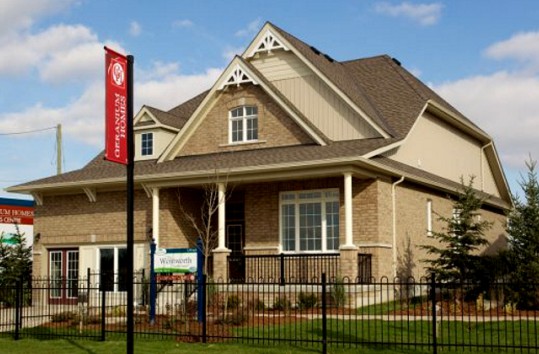
The first home in Canada qualified under the new ENERGY STAR® for New Homes (ESNH) Standard was unveiled last week in Guelph Ontario.
The custom home, built by Sloot Construction Ltd., is located in Phase II of the Hale's Manor community in Guelph.
Attendees at the unveiling were provided with a pictorial overview of the energy-efficient features of the home and an airtightness test demonstration, one of the stringent criteria for qualification under the ESNH Standard that also requires the inclusion of energy-saving features such as:
- Efficient heating and cooling systems;
- More insulation in walls and ceilings;
- High-performance ENERGY STAR® windows, patio doors, and skylights;
- A heat recovery ventilation for fresher air; and
- Electrical savings of a minimum of 400 kilowatt-hours through inclusion of ENERGY STAR® lighting, appliances and/or air conditioners.
The ENERGY STAR® for New Homes initiative was developed by Natural Resources Canada to help the public easily identify homes that are approximately 20 per cent more energy efficient than those built to minimum building codes.
To receive the ENERGY STAR® qualified label, homes are inspected to ensure they meet the technical requirements for energy efficiency developed by the Government of Canada. Each ENERGY STAR® qualified home is third-party verified by Certified Energy Evaluators, and labelled by EnerQuality, a licensed Service Organization.
The ENERGY STAR® name and symbol are registered trademarks of the United States Environmental Protection Agency (US EPA) and are administered and promoted in Canada by Natural Resources Canada.
"The home building industry, led by innovators like Sloot Construction, continues to demonstrate its capacity to aim higher and do better," said EnerQuality's Corey McBurney. "The new national standard raises the bar for better-built homes, and sets a benchmark that is readily achievable by both custom and production residential builders."
"In five years, this Standard will be the 'new normal', as it will inform the Ontario Building Code minimum requirements," McBurney continued.
Building codes around the world are moving quickly toward low-carbon and carbon neutral performance standards. The National Energy Code for Buildings in Canada recently published the first generation of outcome-based codes for Canada, which is in the process of being adopted by several provinces nationwide.
Retrofitting existing homes and buildings for energy efficiency is a largely latent market which has been highlighted by many policy makers as a primary means by which to create jobs while reducing community energy consumption and greenhouse gas emissions.
GLOBE Advisors is currently working on a project in British Columbia on behalf of utilities and the provincial government to develop a strategy for further developing the home energy performance industry in that province - a strategy that will focus largely on increasing consumer demand for retrofit activities and catalyzing industry support for related activities and services.
Municipal building codes (where relevant) are also raising the bar for energy performance of the building stock.
In Vancouver for example, the Greenest City Action Plan has established a 2020 goal for all new buildings to be carbon neutral and the existing building stock as a whole is to be 20 per cent more energy efficient. Achieving this goal requires a shift to performance-based codes and to a building design approach which focuses on a building's envelope first.
Source: Globe-Net


